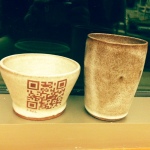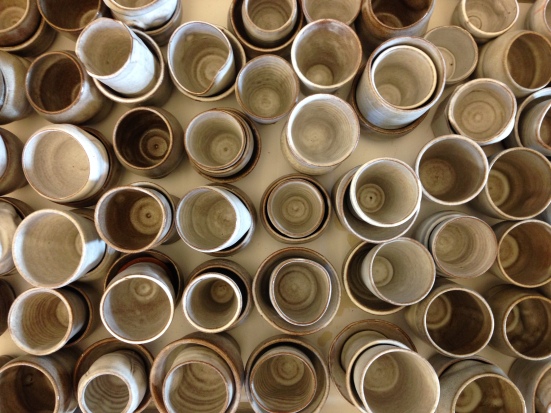“I don’t think I even know how to stand still and not try,” one student says.
Several students and I are in the studio after school, creating cups. The topic of conversation is ‘senior slide,’ and how yesterday might have been the perfect ‘senior skip day,’ but, really, isn’t October too early in the year for such shenanigans?
Another student adds, “I don’t know if I’d be able to look a teacher in the eye if I skipped, or did the slide.” They agree that it’s an issue of mutual respect.
“Some of my friends, though, that’s what they’re living for – as soon as they’re accepted to college, that’s when they will quit. And they can’t wait.”
All the while during this conversation, they are throwing, trimming, sanding cups. We are well on our way to the two hundred we committed for an upcoming installation – but not there yet. There are less than two weeks to go, so the energy has escalated. We are all closing out each day with ruined khakis, the iron in the red clay producing stains that never quite go away.
They are not getting assessed or graded on this project. It’s not for credit. In some ways, they are following me blindly into a crazy idea, one that might not work out in exactly the way we expect. We are putting together an installation at Harvard, in a library, and six students are my equal collaborators. We are making, and we are interviewing others, and we are improvising together. I’m still not completely sure how it happened, but there is no turning back now.
Last week, a colleague asked me how I selected the students whom I invited to participate. Without hesitation, I responded, “They are the tryers.” Not the best artists – although all of them are very talented – and not the academic stars – though most of them do very well. The students who were the obvious choices for this team were the ones who are the most persistent. Some of them are persistent to the point of being stubborn. A few of them challenge me, and ask me questions that make me think twice about my own processes.
And all of them are fluent with the demanding daily rhythm of working with clay.
“Oh, totally. I’ll do that. Fair.” Catching the tail end of this conversation between two of my collaborators, of course I was curious. Laughing a little, they explained that they had worked out a trade – swapping interviews for cups. Now, one is making five more cups, and another is doing five more interviews. They have identified their strengths, and are adjusting plans – because they are tryers who know how to get the job done.
So when I hear a student tell me that he doesn’t know how to “not try,” I can’t help but hope that the crazy daily rhythm of making, failing, making, persisting, and making some more in the studio has contributed to that ethic. I hope that the mutual respect and the trust of working together is becoming habit. And I hope that these ethics stick with him for the rest of his life.
—
Here’s a personal – and technical – note on persistence. My end of the job involves firing the kilns, and we definitely had a glitch in firing last week.
 The glaze we are using is rated for Cone 6 (around 2264° F), and that’s where I started firing it. However, it’s important that it fires opaque enough that the QR codes we apply for a second cooler firing are readable. The first two batches of glazed cups looked beautiful – like the cup on the right in this picture – but when we tried a QR firing, the code fired unreadable, mixing in to the variations of the glaze.
The glaze we are using is rated for Cone 6 (around 2264° F), and that’s where I started firing it. However, it’s important that it fires opaque enough that the QR codes we apply for a second cooler firing are readable. The first two batches of glazed cups looked beautiful – like the cup on the right in this picture – but when we tried a QR firing, the code fired unreadable, mixing in to the variations of the glaze.
When I tried another firing to Cone 5 – around 2185° F – the glaze came out too white and splotchy. It was obviously underfired.
Three test kilns (each firing takes at least 24-hours start-to-finish) and a round of research over a holiday weekend, and I figured out what I needed to do. Take the kiln to Cone 5, and hold at cone temperature for ten minutes. Now we are re-glazing about two kilns of cups to make sure that we get the right effect and surface for the QRs. The latest cups are gorgeous, and work wonderfully with the QR codes – like the one pictured on the left, above.
I suppose I’m a tryer, too. With results like the cart unloaded today, and the studio environment that produced the work, very extra hour feels worth it.







